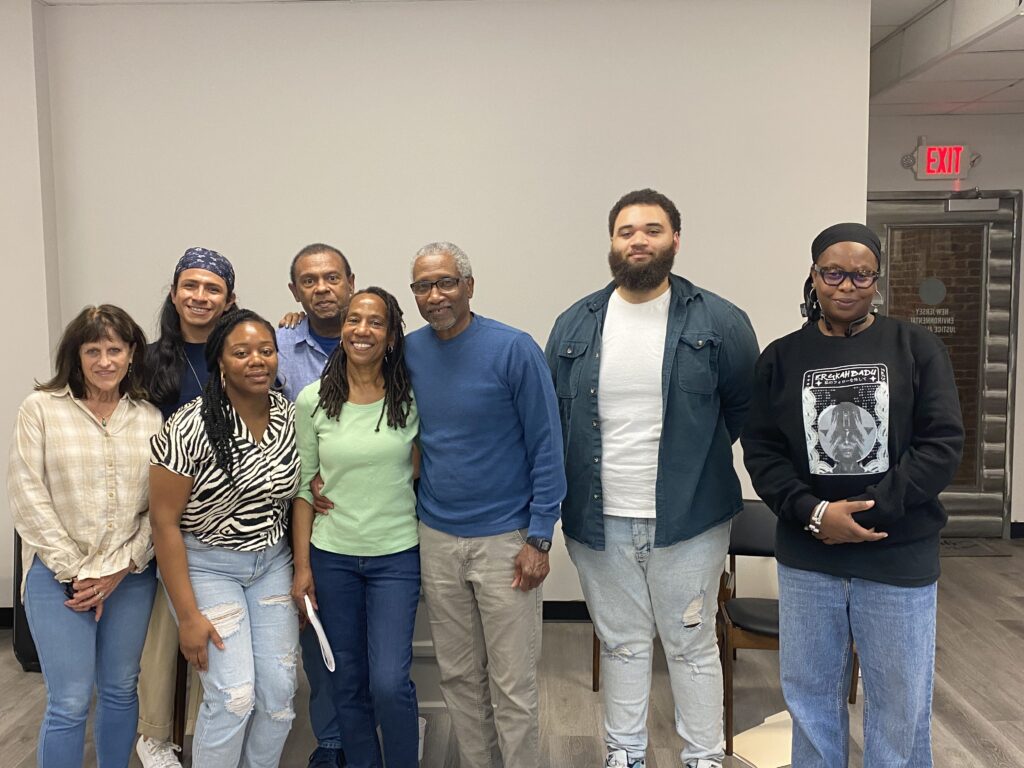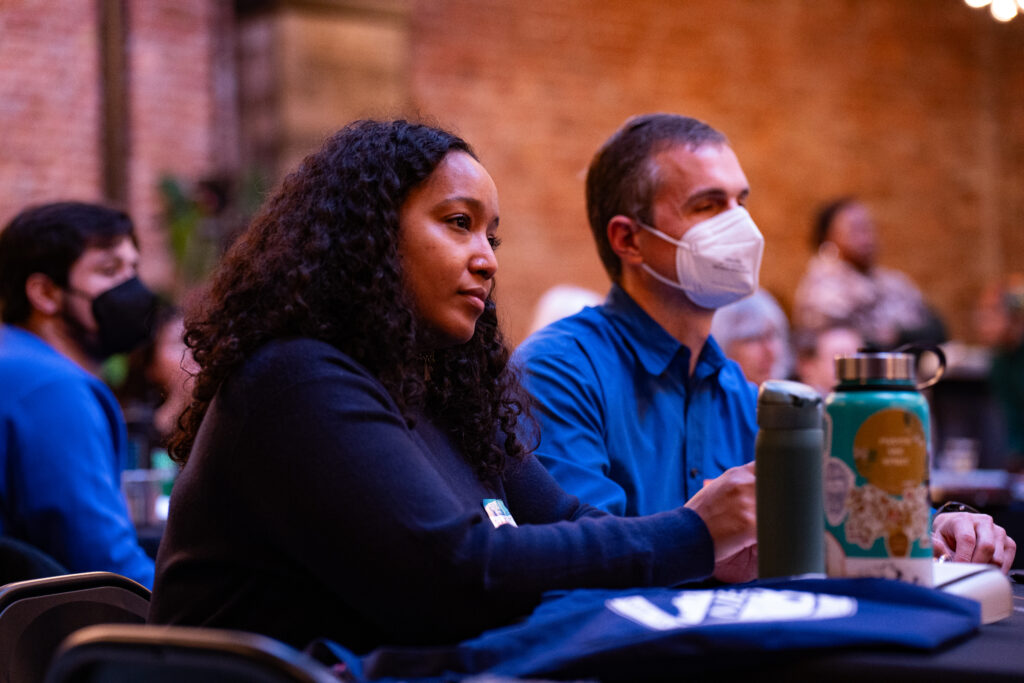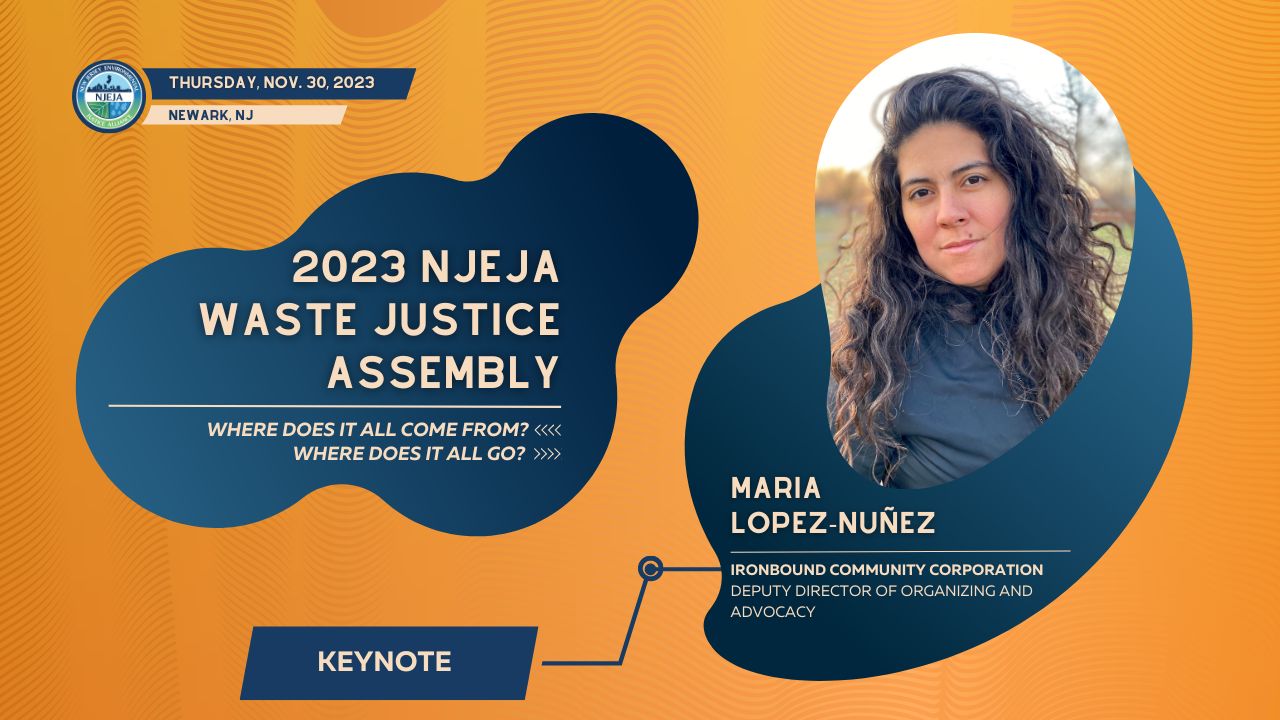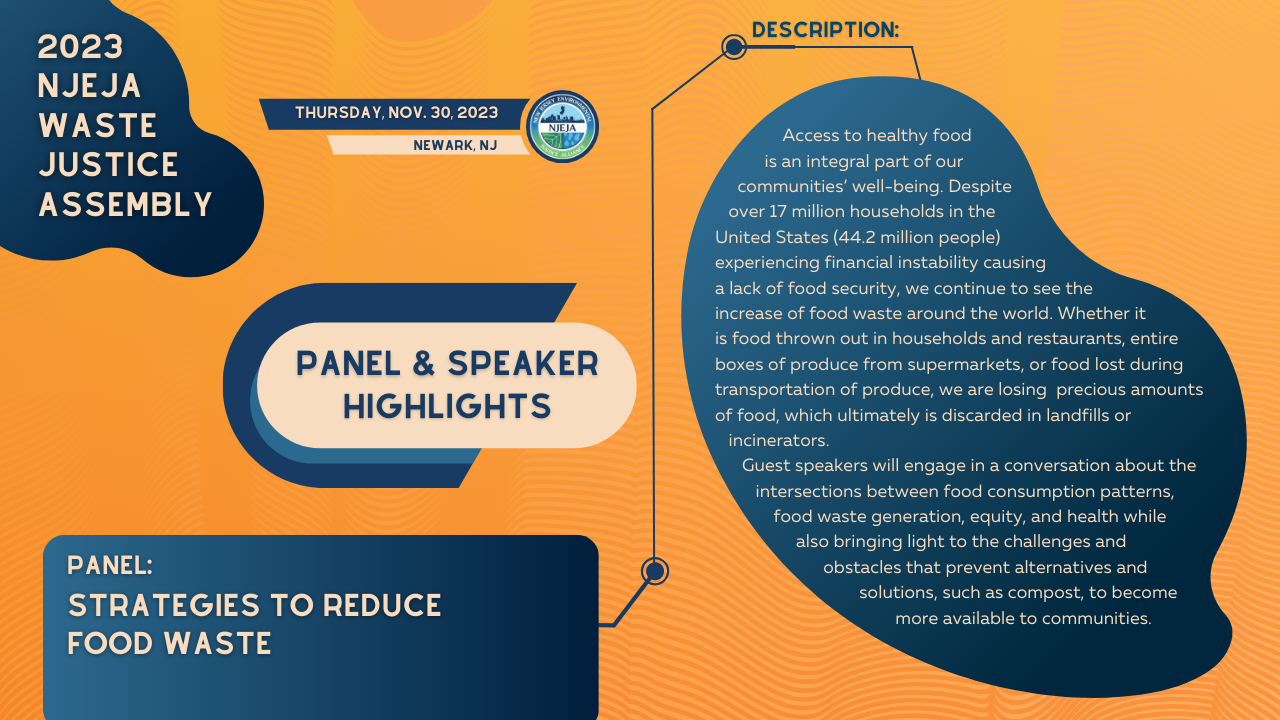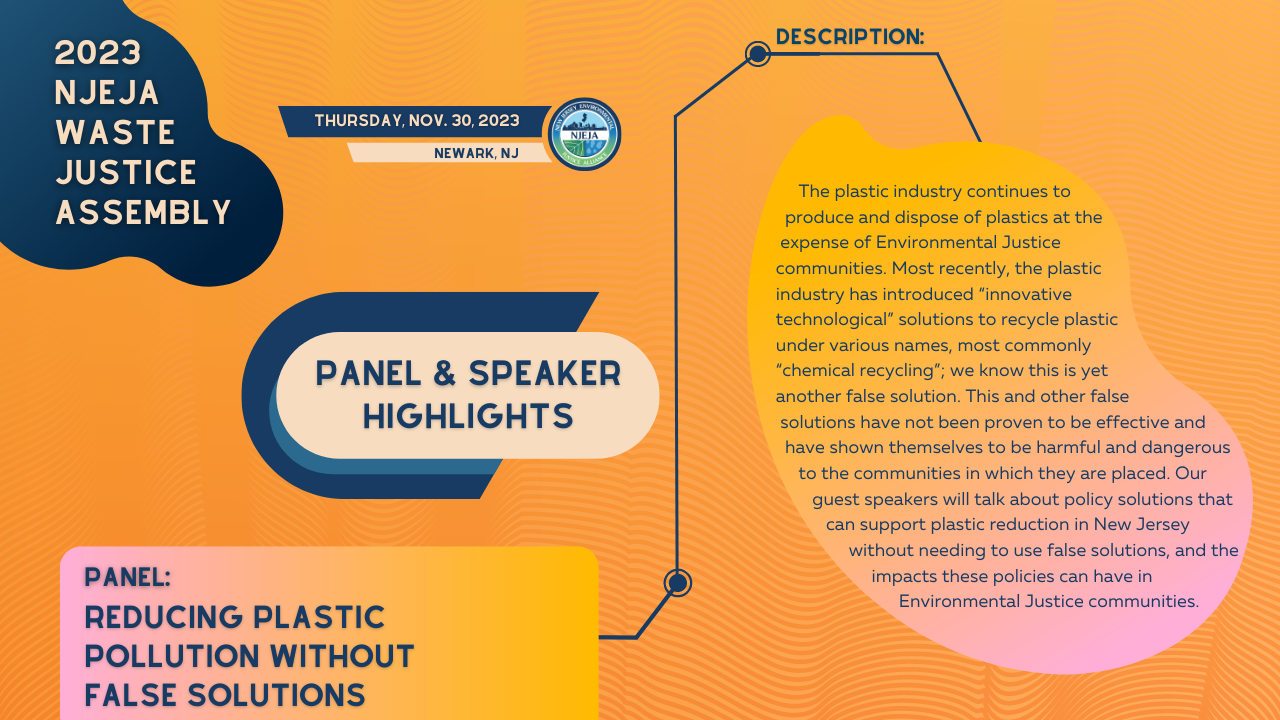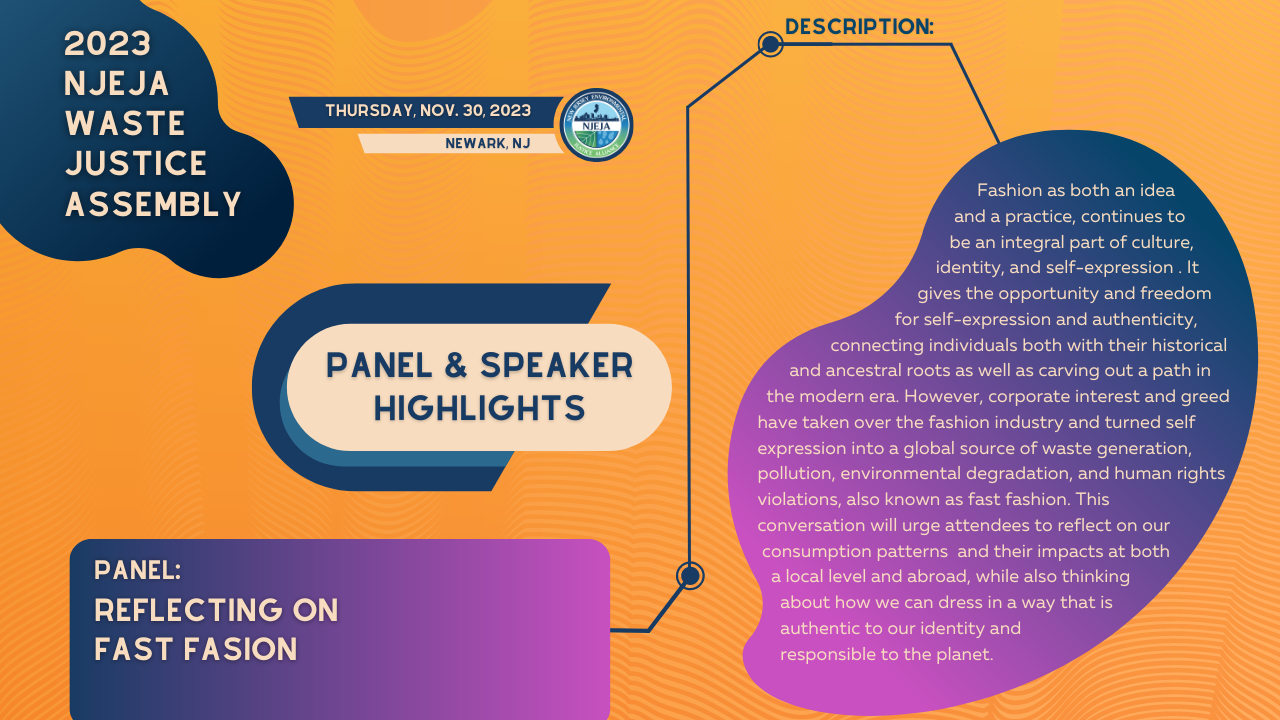Environmental Justice Concerns with Carbon Capture and Hydrogen Co-Firing in the Power Sector
Read the latest report on Environmental Justice Concerns with Carbon Capture and Hydrogen Co-Firing in the Power Sector, prepared in partnership with the New School Tishman Environment and Design Center, Center for the Urban Environment of the John S. Watson Institute for Urban Policy and Research at Kean University, and the Center for Earth, Energy, and Democracy.
For questions, please reach out to Brooke Helmick, Director of Policy at brooke@njeja.org.
Celebrating Cohort 2 of the NJEJA Offshore Wind Program! 
Environmental Justice Advocates Testify in Trenton on the Proposed Clean Energy Standard
NJEJA Celebrates Success of Inaugural Offshore Wind Training Program
2023 Fall Film Series: Exploring the Intersections of Environmental Justice
2023 NJEJA Waste Justice Assembly Recap
Environmental racism persists, and the EPA is one reason why
The Center for Public Integrity, Aug. 3, 2015
The EPA office tasked with policing alleged civil rights abuses is chronically unresponsive to complaints and has never made a formal finding of discrimination
By Kristen Lombardi, Talia Buford, and Ronnie Greene
The invasion of sewer flies moved residents of University Place subdivision to turn to the U.S. Environmental Protection Agency for help. Darting from a neighboring sewage plant, the flies descended upon the mostly African-American neighborhood in Baton Rouge, Louisiana, with such regularity that one resident posted this warning sign: Beware of attack fly.
In 2009, residents grew so sickened by the flies, odors and pollution emanating from the city’s North Wastewater Treatment Plant that they sought out the federal agency that has touted the importance of tackling environmental racism.
“The citizens of University Place Subdivision are still suffering through the dreadful, unhealthy, and downright shameful conditions forced upon this community,” wrote Gregory Mitchell, whose mother, Mamie, erected that attack-fly warning atop her home, in a complaint filed with the EPA’s Office of Civil Rights.
A little-known niche within the EPA, the civil-rights office has one mission: to ensure agencies that get EPA funding — like the city of Baton Rouge — not act in a discriminatory manner. The mandate comes from Title VI of the federal Civil Rights Act of 1964, a sweeping law prohibiting racial discrimination by those receiving federal financial assistance. Experts say the provision presents a significant legal tool for combating environmental injustice.
Time and again, however, communities of color living in the shadows of sewage plants, incinerators, steel mills, landfills and other industrial facilities across the country — from Baton Rouge to Syracuse, Phoenix to Chapel Hill — have found their claims denied by the EPA’s civil-rights office, an investigation by the Center for Public Integrity and NBC News shows. In its 22-year history of processing environmental discrimination complaints, the office has never once made a formal finding of a Title VI violation.
Months after receiving the Baton Rouge community’s Title VI complaint, the office rejected it. Investigators declined to examine the claim that the city had violated the civil rights of black property owners around the North plant, citing a pending lawsuit filed by residents against the city.
In 2010, Mitchell and neighbors again turned to the EPA and, again, the agency said no. Settling their lawsuit later that year, the residents logged a third complaint charging the city had discriminated against them. This time, the EPA rejected it on another technicality — it was “not timely.”
By 2012, they had returned to the EPA a fourth time, only to get a fourth rejection. Few communities have been rebuffed more than Baton Rouge. The distinction has left residents like Mitchell feeling as though regulators “say something to blow you off and just forget about it.”
“Under the EPA’s civil-rights division,” he said, “nothing is done.”
A pattern of rejection
The Baton Rouge case is extreme but not unique. The Center filed a Freedom of Information Act request seeking every Title VI complaint submitted to the office, and every resolution of those complaints, since the mid-1990s. The agency produced records representing most of the complaints handled in that time, but not all. The records, consisting of thousands of pages of documents, cover 265 Title VI cases and stretch from 1996 to mid-2013.
The records reveal a striking pattern: More than nine of every 10 times communities have turned to it for help, the civil-rights office has either rejected or dismissed their Title VI complaints. In the majority, the office rejected claims without pursuing investigations. On the few occasions that it did, it dismissed cases more often than it proposed sanctions or remedies. Records show the office has failed to execute its authority to investigate claims even when it has reason to believe discrimination could be occurring, such as in Baton Rouge.
Of the cases reviewed by the Center, the EPA:
- Rejected 162 without investigation;
- Dismissed 52 upon investigation;
- Referred 14 to other agencies, including the departments of Justice, Health and Human Services and Transportation;
- Resolved 12 with voluntary or informal agreements;
- Accepted 13 for investigations that remain open today, the oldest begun in 1996.
The EPA rejected complaints for a host of procedural reasons, records show. The most common reason (95 cases), complaints were denied was because the EPA said their targets did not receive agency funding, as is required by law. Other complaints (62) came in too late for action, it said, because they fell outside a 180-day time limit that the agency has authority to waive. Still others (52) were tossed because of “insufficient” claims, meaning they did not adequately describe the alleged discriminatory acts forbidden under Title VI. The EPA, in essence, requires complainants to have knowledge of civil-rights law and other nuances before filing a case. They are assumed to know, for example, that Title VI does not apply to private companies unless they receive EPA funding.
One thing is clear: While the reasons vary, the EPA’s civil-rights office rarely closes Title VI complaints alleging environmental injustice with formal action on behalf of communities of color.
Indeed, as the records reveal, the agency often found allegations “moot” precisely because of its own inaction. Agency regulations set a 20-day deadline for the office to determine whether it will investigate a case. Yet in cases dismissed as moot — nine over 17 years, or 4 percent — the EPA took, on average, 254 days — excluding weekends and holidays — just to make such a jurisdictional decision.
The delay, in itself, is a form of denial. At times, the EPA has taken so long to decide whether to open an inquiry that situations on the ground changed — an asphalt plant closed, for instance, or a waste facility withdrew its permit application. Other times, communities have remained in limbo for years as agency investigators ruled on the alleged discrimination.
In July, five communities — in Alabama, Michigan, Texas, New Mexico and California — sued the EPA for failing to finish investigations pending for more than a decade. The litigation, filed by the environmental law firm Earthjustice, challenged what it called the agency’s “pattern and practice of unreasonable delay…” The delays have forced residents to endure pollution from a landfill, an oil refinery and three power plants, the lawsuit said. The EPA itself classifies two of the power plants and the refinery as “significant” violators of the Clean Air Act.
Even among the small universe of cases sparking action — 64 over 17 years, or 25 percent — records suggest the civil-rights office rarely closes investigations with formal sanctions or remedies. Under Title VI, EPA officials can correct an act deemed discriminatory by requiring reforms, or overturning decisions. It can also withhold funding or refer cases to the Justice Department for prosecution.
Only nine cases have been settled through agreements brokered between agency officials and targets of complaints. Another three cases have been closed through “alternative dispute resolutions,” meaning the complainants and the targets hashed out solutions.
Asked about this record, the EPA did not dispute the Center’s findings. Instead, the head of the EPA’s civil-rights office, Velveta Golightly-Howell, declined to discuss cases prior to her tenure, which began in February 2014. In a half-hour telephone interview with the Center and NBC News, she stressed that the EPA is committed to “making a visible difference in communities,” and is “making a lot of strides” to improve its Title VI enforcement.
“It is important to note that ‘finding a formal Title VI violation’ is not the ultimate objective as [a] civil rights office,” Golightly-Howell said in a written response to follow-up questions. “The most important objective is to bring about prompt and effective resolution of cases in order to address discrimination issues as quickly and thoroughly as possible.”
She acknowledged that “there have been some problems in the past” processing Title VI complaints.
“We cannot focus on the past because there’s nothing we can do about it,” she said. “We can, however … focus on the present and the future, and that’s what we’re doing.”
To advocates, the EPA’s pattern of denials, delays and dismissals speaks louder than the agency’s words — from not only Golightly-Howell, but also Administrator Gina McCarthy, who in March gave the keynote address at a national conference on environmental justice, in Washington, D.C. Throughout her 20-minute speech, the administrator touted how the agency has promoted environmental justice in disadvantaged communities across the country. Not once did she mention the agency’s civil-rights office.
Listening to McCarthy’s speech, Richard Moore, an advocate from New Mexico, said, “You have to put the proof in the pudding. At the end of the day, we see no major activity taking place through [the agency’s] Office of Civil Rights.”
Searing critiques
The dysfunction has been well known to EPA officials for years. Auditors and advocates alike have criticized the agency’s civil-rights office for such systemic failures as compiling a lengthy backlog, having an opaque complaint process and misconstruing a key legal standard. In the past decade, reviewers, internal and external, have offered critiques.
One of the most damning was a 2011 Deloitte Consulting report that concluded the office “has not adequately adjudicated Title VI complaints.”
The EPA moved slowly to process complaints, Deloitte found. “Only 6% of the 247 Title VI complaints [reviewed by Deloitte] have been accepted or dismissed within the Agency 20-day time limit,” the audit stated. The backlog of cases stretched back a decade, to 2001.
The report depicted an office in turmoil. Managers had little ability to track employee performance. Record keeping was spotty. The civil-rights program took few steps to tap into EPA’s larger resources, and connect with state environmental agencies — a lack of outreach that left it operating in an insular fashion.
The result: An office that appeared more ceremonial than meaningful, with communities left in the lurch.
Since Golightly-Howell joined the office last year, she said, the focus has been on “creating a robust and revitalized civil rights enforcement program.”
In the years following the Deloitte audit, the office has taken steps to address its findings — tackling its massive backlog, for instance, and issuing two agency-wide orders to create what she called a “model” civil rights program.
The office has been “proactive,” Golightly-Howell said, adding a grant condition ensuring that those receiving EPA funding comply with civil-rights law. According to a progress report released in May, the office is also developing a “toolkit” to help state and local agencies understand the law, as well as a manual for EPA investigators who examine complaints.
“The whole goal is not to have complaints sitting in the office for years and years and years without there being some resolution,” Golightly-Howell said.
For communities, the changes have meant little.
That has been true, for example, for residents of the Rogers Road-Eubanks Road neighborhood, in Chapel Hill, North Carolina, whose case has been stuck in the EPA’s Title VI complaint pipeline for eight years now.
The historically African-American neighborhood is the site of an expansive county solid-waste landfill and transfer station collecting auto parts, biological waste, transformers — “you name it,” said Robert Lee Campbell, of the Rogers-Eubanks Neighborhood Association. In 2007, the association filed a Title VI complaint alleging that local government agencies discriminated against the adjacent black property owners, first siting the landfill there, and then not providing such basic amenities as water and sewer services. It followed up with a 2011 addendum of allegations to bolster its case.
It took nearly a year for residents to hear from the EPA’s civil-rights office, which in 2008 and again in 2011 requested more information. Over the years, Campbell recalled his association and its lawyers sending the agency 12, two-pound boxes of documentation. They fielded occasional phone calls from an ever-rotating roster of agency investigators.
“We were always getting, ‘We’re still looking into the complaint,’ ” said Campbell, who has lived 2,500 feet from the dump site since the 1970s. “Not a whole lot about what they were going to do to help us.”
By 2013, the EPA had denied some of the residents’ claims on procedural grounds, but not all. The agency accepted the amended complaint for investigation almost a year after the county, responding to residents’ decades-old political activism, shuttered the landfill. In its place the county has installed trash-disposal operations handling yard debris and electronics waste, along with a recycling center.
Today, the case is languishing on the agency’s current list of 17 open investigations.
“We have no idea what’s happening,” said Mark Dorosin, of the University of North Carolina’s Center for Civil Rights, which has handled the complaint. “It’s been very frustrating.”
Cases that have seen action from the EPA since the Deloitte report have not necessarily fared better.
Consider the outcome for residents in California’s San Joaquin Valley, who, as far back as 1994, complained to the EPA about the sulfur and garlic-like chemical odors and the clusters of chronic illnesses surrounding three hazardous-waste facilities there. The mostly Latino communities of Kettleman City, Buttonwillow and Westmorland bore the brunt of these impacts, residents said, yet had little opportunity to participate in the permitting processes.
The EPA’s civil-rights office accepted the complaint for investigation in 1995, but took 17 years to examine the allegations. Only after residents had sued the EPA, in 2011, did the agency act.
In 2012, the EPA dismissed the case without ruling on whether the sites discriminated against residents. The agency also said it could trace no adverse health impacts to the three facilities, even though they lie within an area the agency has found exceeds all air-quality standards. EPA’s decision came down in the middle of the lawsuit, which the court then dismissed as moot. An appellate court affirmed that decision.
“Congress wanted agencies to enforce [Title VI],” said Brent Newell, of the Center on Race, Poverty and the Environment, in San Francisco, which was involved in the so-called Padres case, and has filed multiple complaints on behalf of minority communities nationwide. “What’s the point of having the agency if they’re not going to do it?”
Strong odors, swarms of bugs
In Baton Rouge, residents of the University Place subdivision have not given up on the EPA’s civil-rights office — yet. Viewing theirs as a classic struggle against environmental discrimination, they have pressed the agency for help — again and again — in recent years.
“I wanted EPA to do its job,’” said Gregory Mitchell, the lead community activist, explaining why he and as many as 312 other residents have signed on to the Title VI complaints.
When the North sewage plant began operating in 1960, the structure was barely visible to its neighbors. Over the years, the city has transformed it into an industrial complex stretching for blocks, separated from houses by a two-lane road. As the plant grew larger, community staples faded. A ballpark was closed, a community store shuttered. In their place came the flies and the stench.
State records document the hazards.
In 1998, a memo from the Louisiana Department of Health and Hospitals detailed “strong odors” coming from the sewage plant, and “filter flies nesting all under carport walls and side entrance door” at Mamie Mitchell’s house adjacent the sewage plant. In 2009, the same department documented, again, “flies on the windows, around the doors, and on the walls under the carport.”
The problem was so bad, Mitchell said, that the city used to supply her with air fresheners and boxes of bug killers. Still, the swarms kept coming, fouling the outdoor calm she said she found when she moved to the house in 1972.
By the time she and other residents turned to the EPA’s civil-rights office six years ago, they had long since sued the city. Their lawsuit, filed in 1996, was stuck in the courts for more than a decade. It ended in 2010 with a ruling that the plaintiffs were not entitled to recover personal-injury damages.
Clean Water Act litigation filed by the residents and a local environmental group eventually yielded some relief, helping to lay the groundwork for a city vote in 2013 to relocate some away from the sewage plant and to create a “buffer” area, a process that is ongoing.
All the while, residents have pushed the EPA for help. Gregory Mitchell did not sit idly as the civil-rights office weighed his requests for action, and then dismissed them starting in 2010. He peppered regulators with constant pleas.
“We the citizens/I would like an update on the status of the civil rights and EJ [environmental justice] paper work which has been in your office for a very long time,” he wrote in May 2012.
An agency official asked him to include the EPA file number with his emails. Mitchell did so that June, and added another plea. “We have been in constant contact with your office over the years,” he wrote. “We consent again to your office to do what is needed, because our civil rights and EJ rights are continuing to be violated.”
A day later, June 6, 2012, Mitchell asked for a written status update. “Please detail what your office has done, is doing, and will continue to do,” he wrote. “Our community is still suffering.”
Another official told him his latest complaint was still under jurisdictional review, meaning the agency was considering whether to open an investigation. By August of 2012, plant critics’ patience was wearing thin.
“Why is this office taking so long to accept our claims,” Mitchell wrote the EPA. “Time for this office to take action and not play games with our lives.”
The EPA closed that complaint, like the previous complaints. Its final rejection letter said Mitchell did not cite a specific allegation within the 180-day window. “OCR independently could not identify a specific date of an alleged discriminatory act.”
Mitchell said the community lives with the smells and sewer flies every day. Over the years, he said, agency investigators have mentioned other reasons the civil-rights office might deny his claims — questioning whether the city was receiving EPA funding, for instance.
“All these complaints to EPA have gotten us nothing — zero,” he said in a recent interview. “It’s as if the city did nothing, and this is the way people are supposed to live.”
He has filed a fifth, still-pending complaint to the civil-rights office.
Asked about Baton Rouge, the EPA referred to its rejection letters explaining why the cases were closed. The agency said it has helped the community in other ways, supporting an agreement by the city council to relocate residents away from the sewage plant, and “to create a 300-foot buffer zone around the facility.” Under a U.S.-city consent decree dating to 1988, the agency’s regional office in Dallas has monitored North plant operations. The decree settled an EPA enforcement action brought against the city after years of water pollution violations.
“Although the OCR rejected the referenced complaints, the Office supported EPA Region 6’s other efforts to mitigate environmental health issues stemming from the [North] Wastewater Treatment Plant,” the agency said in a written statement.
The plant is undertaking $24.1 million in odor- control projects as well, according to the agency. EPA officials “continue to monitor the implementation of these efforts,” the agency said.
Many residents have now chosen to flee. Even the Mitchell family, long the neighborhood’s holdout, has left the subdivision in recent months. Still residing in Baton Rouge, Gregory Mitchell said his family as well as his mother and her siblings do not miss the malodorous sewage plant. But they had to abandon homes in which they had lived for many years and neighbors to whom they had grown close.
“Our community is gone. It’s no longer there,” said Mitchell, who, if rejected yet again, plans to file a sixth Title VI complaint with the EPA.
“That’s a total civil-rights violation,” he said. “Tell me that’s not a civil-rights violation.”
==============
Clarification, August 3, 2015, 9:28 a.m.: An earlier version of this story said that Title VI does not apply to private companies. The phrase “unless they receive EPA funding” was added for clarity.
Five Lessons for Democrats From the Black Lives Matter Protests
CNN.com, August 13, 2015
By Van Jones
Many observers are perplexed by the decision of some Black Lives Matter activists to twice disrupt attempted addresses by presidential hopeful Sen. Bernie Sanders.
Well, I am not perplexed. The new generation of civil rights activists never accepted “trickle-down economics” from conservatives. Today they are rejecting “trickle-down justice” from the liberals.
I love and admire Sanders. But until the Black Lives Matters activists started snatching away their microphones, economic populists like him rarely spotlighted the specific pain that has been building in the African-American community. Instead, they focused mainly on so-called “class issues” – including the need to defend Social Security and Medicare/Medicaid, rein in Wall Street and the Koch Brothers, and tax corporations and rich people.
Many African-American leaders support those policies. But we have needed and wanted more. Our economic problems include an unemployment rate that is double that of whites, racially biased policing and court systems, predatory lenders who deliberately target black neighborhoods and public schools that expel black children at staggering rates for minor offenses.
Over the years, many black leaders have asked the populists to include specific remedies for our specific ills. We have done this politely and behind closed doors. Often we would hear that their “progressive economic policies” would disproportionately help black folks, so we should be fine with our community’s needs never being addressed by name.
It was infuriating. Sometimes, it seemed some Democratic politicians were happy to publicly name and embrace every part of the Democratic coalition – immigrants rights defenders, womens’ rights advocates, environmentalists and champions of LGBT equality. But not black people.
At least, not explicitly – and certainly not comfortably. We were just supposed to sit there and hope that race-neutral rhetoric and race-neutral proposals might somehow fix our race-specific problems.
I started calling this dubious strategy “trickle-down justice.”
Today’s young activists simply are not having any of it.
In case anyone missed the memo after Ferguson, Baltimore and Charleston, here it is: the Obama era of black silence on issues that matter to us is over.
And the entire Democratic Party needs to sit up and take notice.
Black Lives Matter has elevated the national discussion of anti-black racism more dramatically than any movement in decades. It is the only “progressive” force besides Hillary Clinton that the GOP was forced to acknowledge in its first debate last week. By any measure, and especially for such a new phenomenon, that’s an extraordinary achievement.
Pundits tend to portray the modern Democratic Party as having only two factions: the pro-business/Wall Street “moderates” (traditionally represented by the Clintons) versus the economic populists (now represented by Elizabeth Warren and Bernie Sanders).
But a third force is rising: a growing, racial justice wing (best represented by the Dreamers and Black Lives Matter) that is highly suspicious of both – and finds the clueless hypocrisy of the second to be particularly grating.
Here are some things to consider.
1. Black Lives Matter is not a single organization.
Black Lives Matter is not a single organization – at least not in the conventional sense. It represents the expression of tens of thousands of activists, doing what they think makes sense, in hundreds of different places.
In that regard, it shares some features with Occupy, the tea party and the Arab Spring uprising. It is a “swarm” – a decentralized network, using an “open source” brand. Such phenomena are notoriously messy and difficult. But they are powerful and necessary to change anything in the present era.
So I will not agree with every single choice, in every time and every place, made by every activist who is inspired by Black Lives Matter. But I don’t have to endorse or embrace every tactic for me still to speak with deep respect and warm regard for a force that is becoming the most important movement against anti-black racism in decades.
I would hope that would be true of everyone.
Whatever injury befell Sanders this weekend, worse injuries have fallen upon the young women who grabbed the microphone – perpetually made to feel wrong, out of place, less than, even criminal their whole lives purely based on the color of their skin. Obviously, that sad fact does not excuse anything and everything that any BLM-inspired activist does. But it is something that is useful to keep in mind, as we search for pathways to unity.
2. It is not just about Bernie Sanders…
It turns out the Seattle activists’ actions were aimed less at Sanders himself and more at racistpractices and policies being tolerated by local liberals in a supposed progressive bastion like Seattle. The Seattle Police Department has been under investigation for years for racist scandals and problematic use of force. Black children in King County schools are suspended at higher rates than their white peers. And the region is wasting $210 million on a new jailinstead of investing in communities.
The gulf between the region’s political reputation and its racial reality is not surprising to me. Nor is Seattle unusual. Far too many progressives are working within social networks that are almost monolithically white. In my experience, too few have focused on building authentic bridges beyond their monochromatic comfort zones.
Therefore, they are not really any more tuned in to the daily lives of people of color than the average moderate or even conservative. That’s why their prescriptions for change often ring hollow and fall flat – at least outside their own company.
3. … but it is fair to hold Sanders to a higher standard.
Some argue that the #BlackLivesMatter movement should focus its fire on Republicans. But the GOP generally does not pretend to be a champion of the economic underdog. And unlike Hillary Clinton or Martin O’Malley, the central conceit of Sanders’ campaign is that he represents a voice of moral clarity against skyrocketing inequality.
For example: any fair discussion of “income inequality” must necessarily include a denunciation of our racially biased criminal justice system. Always.
After all, it is hard to get a job after a judge labels you a felon. African-Americans and white people do drugs at the same rate. But the system incarcerates African-Americans at SIX TIMES the rate of whites, for the exact same behavior. This injustice is a major driver of economic inequality in the black community. It should be a part of ANY speech about economic inequality in the United States – and not just in speeches made to black audiences.
Therefore nobody should have had to push Sanders to tackle criminal justice issues. To the contrary, especially given the turmoil of the past year, the devastating impact of the incarceration industry should have been a key part of his very first speech as a presidential candidate.
To his credit, Sanders has quickly and admirably adapted. Since BLM protesters disrupted his time on stage at Netroots Nation,Sanders has made powerful speeches and statements. He has posted important, relevantpolicy prescriptions on his website. Sanders’ 2015 rhetoric may finally start to match his pro-civil rights voting record in Congress. Of course, he could go further. And I suspect he will.
4. Bernie’s supporters have failed to keep pace with Sanders’ progress.
Unfortunately, the vitriol from many of Sanders’ incensed backers is not helping his cause. It pains me to say this. But I continue to observe shocking levels of racial paternalism, arrogance and condescension in my personal and online interactions with Sanders’ outraged supporters. They remain tone-deaf or worse on issues that specifically or disproportionately hurt African Americans. And the situation seems to be getting worse, not better.
One first-person account of the Sanders rally in Seattle says the mostly white, liberal crowd“turned ugly” after the activists spoke up. If this behavior had taken place at a tea party rally, Sanders’ supporters would have condemned it.
Some so-called “progressives” even took tocombing through the social media accounts of the young women who have protested Sanders, in search of damaging statements. These are the same tactics that progressives denounce right-wingers for employing – when they try to smear any unarmed, young black person whom the police have killed.
I do not know what kind of relationship the local white activists in Seattle actually have with young black/brown/native activists. But I bet it falls into one of three categories: nonexistent, tokenizing or condescending/condemning. Because, sadly, those are the only choices on the menu in most U.S. cities.
Today’s young activists won’t put up with that relationship any longer.
5. Beyond emotions – here is the hard math.
The challenge for all Democrats now is not raw emotion – but hard math.
For Democrats to win the White House in 2016, African-Americans must give 90-95 percent of our votes to that party’s nominee.
Not 50+1 percent of our vote.
Not even 75 percent.
To put another Democrat in the White House, black folks must be practically UNANIMOUS in our support for a Democrat.
AND then we will have to overcome hundreds of racist obstacles just to get to the poll: being unlawfully purged from voter rolls, getting targeted for voter ID harassment, being forced to stand in understaffed voting lines for hours and hours and more.
AND after all that, we still must turn out in record numbers.
Or the Democrats will lose. Period.
Given that fact, younger African Americans rightfully expect each and every Democratic candidate to explicitly, loudly and enthusiastically address the pain and needs of black lives – to THEIR satisfaction.
That’s fair – since those very candidates will expect those same young activists to turn out millions of voters for them in just a few months. And in pursuit of this goal, I think that most (if not all) of Black Lives Matters’ tactics – including and especially the iconic protest at Netroots Nation – are laudable, praiseworthy and inspired.
Perhaps this generation of young black folks will be the last one the Democrats (and economic populists, generally) can simply presume to take for granted.
If Black Lives Matter succeeds in that and nothing else, it will have built one of the most meaningful political movements of the 21st century.
This article was originally written for CNN.com.
After EPA ignored environmental racism for decades, communities fight back
Common Dreams (July 16, 2015)
By Sarah Lazare
The Environmental Protection Agency has been ignoring complaints about environmental racism across the United States for up to 20 years, repeatedly failing to investigate evidence that incinerators, power plants, and hazardous waste dumps are disproportionally harming the health of low-income communities of color, a new lawsuit charges.
Filed July 15, 2015 by environmental advocacy organization Earthjustice on behalf of communities across the country, the lawsuit argues that the EPA failed to take adequate action in response to complaints that states were violating civil rights laws by granting permits to hazardous polluters primarily in poor and working-class Black and Latino neighborhoods.
Residents and lawyers identify environmental racism relating to: two power plants in Pittsburg, California; a landfill in Tallassee, Alabama; a hazardous waste dump and treatment facility in Chaves County, New Mexico; a wood-incinerator power station in Flint, Michigan; and an oil refinery in Beaumont, Texas.
In some places, states failed to fully consider the impact of the facilities on local communities. In others, state authorities “actively stopped residents from participating in public hearings on the permits, or provided them with inaccurate information,” a summary of the lawsuit charges.
Complaints were filed to the EPA as early as 1994, with the most recent in 2003. Residents, still waiting for meaningful action from the EPA, say the federal agency is complicit in the harm being done to them.
Neil Carman of the Sierra Club Lone Star Chapter told Common Dreams that the ExxonMobil oil refinery in Beaumont, Texas is right next to a 95 percent African-American community that has been complaining about severe air pollution.
“In 2000 a complaint was submitted to the EPA about a permit, granted by the Texas Commission on Environmental Quality, that allowed an increase in hydrogen sulfide, a toxic gas,” explained Carman. “The only thing the EPA did was write a response letter within a year or two saying they were going to accept part of the complaint. But since then we haven’t heard from the EPA again.”
The July 15 suit charges that the EPA failed to meet its requirements under the Civil Rights Act and demands that the agency investigate and issue recommendations on all of the cases.
“Here in New Mexico, EPA’s inaction has allowed the state to continue to ignore the public, especially low-income communities and communities of color,” Deborah Reade, Citizens for Alternatives to Radioactive Dumping, said in a press statement. “The state disproportionately sites more and more facilities in these communities before old contamination is even cleaned up. It hides public documents, makes it difficult to obtain information in a timely manner and generally refuses to take disparate impacts on Environmental Justice communities into consideration when permitting sites.”




